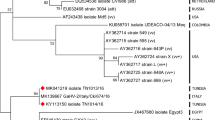Abstract
Marek's disease virus, a herpesvirus, and avian leukosis virus, subgroup J, a retrovirus, are oncogenic viruses of poultry. Both viruses may infect the same flock, the same bird and the same cell. In a double-infected cell, the retroviral DNA can integrate into the cellular or the Marek's disease virus (MDV) genome. The retroviral long terminal repeat (LTR) integration into MDV was first described by Isfort et al., (Proc Natl Acad Sci 89, 991–995, 1992) [1] following tissue culture co-infection. The recombinant virus isolated, RM1, had altered biological properties compared to the parental MDV (Witter R.L., Li D., Jones D., and Kung H.-J., Avian Dis 41, 407–421, 1997) [2]. The issue of retroviral sequence integration into herpesviruses in vivo, in cases of double-virus infection is of wide significance in general virology and veterinary medicine; it also represents a special case of gene transposition. Using the avian system, we aimed to determine occurrence of such integrations in vivo. Chickens were experimentally co-infected with both avian leukosis virus (ALV) subgroup J and with MDV. To demonstrate the presence of the retroviral LTR in the MDV genome we applied the Hot Spot-combined PCR assay (Borenshtain R. and Davidson I., J Virol Meth 82, 119–127, 1999) [3] that consisted of two consecutive steps of amplification. By that HS-cPCR assay, certain MDV genomic sites, defined as HS for integration were specifically amplified, the HS step, and then subjected to screening in an attempt to detect LTR inserts. The screening was achieved by amplification using heterologous primer sets, one for the MDV hot spot and the other for the retroviral LTR, the cPCR step. The products were Southern blotted and hybridized with MDV and ALV-LTR probes. Chimeric molecules were detected and evidenced by an intense signal in 3/10 chickens and weakly in other 3/10 birds.
Detection was by LTR amplification, sequencing and multiple alignment to the ALV-J-LTR sequence. The present study indicated that chimeric molecules were produced in vivo.
Similar content being viewed by others
References
Isfort R., Jones D., Kost R., Witter R., and Kung H.-J., Proc Natl Acad Sci 89, 991-995, 1992.
Witter R.L., Li D., Jones D., and Kung H.-J., Avian Dis 41, 407-421, 1997.
Borenshtain R. and Davidson I., J Virol Meth 82, 119-127, 1999.
Calnek B.W. and Witter L., in Calnek B.W., Barnes H.J., Beard C.W., and Yoder Jr. H.W. (eds), Disease of Poultry. 9th edn. Iowa State University Press, Ames, Iowa, USA, 1997, 369-413.
Payne L.N., Avian Pathol 27, S36-S45, 1998.
Davidson I., Borowsk A., Perl S., and Malkinson M., Avian Pathol 24, 69-94, 1995.
Davidson I. and Borenshtain R., Avian Dis 45, 102-121, 2001.
Ambroziak J.A., Blackbourn D.J., Herndier B.G., Glogau R.G., Gullett J.M., McDonald A.R., Lennette E.T., and Levy J.A., Science 268, 582-583, 1995.
Staskus K.A., Zhong W., Gebhard K., Herndier B., Wang H., Renne R., Beneke J., Pudney J., Anderson D.J., Ganem D., and Haase T., J Virol 71, 715-719, 1997.
Mesri E.A., Cesarman E., Arvanitakis L., Rafii S., Moore M.A., Posnett D.N., and Asch S., J Exp Med 183, 2385-2390, 1996.
Kawaguchi Y. and Mikami T., J Vet Med Sci 57, 801-811, 1995.
Isfort R., Qian Z., Jones D., Silva R.F., Witter R., and Kung H.-J., Virology 203, 125-133, 1994.
Jones D., Isfort R., Witter R.L., Kost R., and Kung H.-J., Proc Natl Acad Sci 90, 3855-3859, 1993.
Jones D., Bronovskis P., Witter R.L., and Kung H.-J., J Virol 70, 2460-2467, 1996.
Kost R., Jones D., Isfort R., Witter R.L., and Kung H.-J., Virology 192, 161-169, 1993.
Sakaguchi M., Sonoda K., Matsuo K., Zhu G.-S., and Hirai K., Virus Genes 14, 157-162, 1997.
Endoh D., Ito M., Cho K.-O., Kon Y., Morimura T., Hayashi M., and Kuwabara M., J Vet Med Sci 60, 227-235, 1998.
Bronovskis P. and Kung H.-J., Virus Genes 11, 259-270, 1996.
Payne L.N., and Purchase H.G., in Calnek B.W., Barnes H.J., Beard C.W., and Yoder Jr. H.W. (eds.), Disease of Poultry. 9th edn. Iowa State University Press, Ames, Iowa, USA, 1997, pp. 414-466.
Bai J., Payne L.N., and Skinner M.A., J Virol 69, 779-784, 1995.
Hertig C., Coupar B.E.H., Gould A.R., and Boyle D.B., Virology 235, 367-376, 1997.
Moore K.M., Davis J.R., Sato T., and Yasuda A., Avian Dis 44, 827-841, 2000.
Whitley R.J., in Fields B.N., Knipe D.M., and Howley P.M. (eds), Virology. 3rd edn. Lippincott-Raven Pub. Philadelphia-New York, 1995.
Rezza G., Andreoni M., Dorrucci M., Pezzotti P., Monini P., Zerboni R., Salassa B., Colangeli V., Sarmati L., Nicastri E., Barbanera M., Pristera R., Aiuti F., Ortona L., and Ensoli B., J Natl Cancer Inst 91, 1468-1474, 1999.
Schulz T.F. and Moore P.S., Trends Microbiol 7, 196-200, 1999.
Takasaki T., Ohkawa N., Sano K., Morimatsu S., Nakano T., Nakai M., Yamaguchi J., and Kurane I., Acta Virologica 41, 221-229, 1997.
Campadelli-Fiume G., Mirandola P., and Menolli L., Emerging Infec Dis 5, 353-366, 1999.
Becker Y., Asher Y., Tabor E., Davidson I., Malkinson M., and Weisman Y., J Virol Meth 40, 307-322, 1992.
Smith L.M., Brown S.R., Howes K., McLeod S., Arshad S.S., Barron G.S., Venugopal K., McKay J.C., and Payne N., Virus Res 54, 87-98, 1998.
Chen H.R. and Barker W.C., Nucleic Acid Res 12, 1767-1776, 1984.
Habel D.E., Dohrer K.L., and Conklin K.F., J Virol 67, 1545-1554, 1993.
Buranthai C., Rodrigez J., and Grose C., Virology 239, 20-35, 1997.
Pearson W.R. and Lipman D.J., Proc Natl Acad Sci 85, 2444-2448, 1988.
Delecluse H.-J., Schuller S., and Hammerschmidt W., The EMBO J 12, 3277-3286, 1993.
Kaschka-Dierich C., Nazerian K., and Thomssen R., J Gen Virol 44, 271-280, 1979.
Rhiza H.-J, and Bauer B., Arch Virol 72, 211-216, 1982.
Van Regenmortel M.H., ASM News 64, 683-687, 1998.
Author information
Authors and Affiliations
Rights and permissions
About this article
Cite this article
Davidson, I., Borenshtain, R., Kung, HJ. et al. Molecular Indications for In Vivo Integration of the Avian Leukosis Virus, Subgroup J-long Terminal Repeat into the Marek's Disease Virus in Experimentally Dually-Infected Chickens. Virus Genes 24, 173–180 (2002). https://doi.org/10.1023/A:1014528818179
Issue Date:
DOI: https://doi.org/10.1023/A:1014528818179




